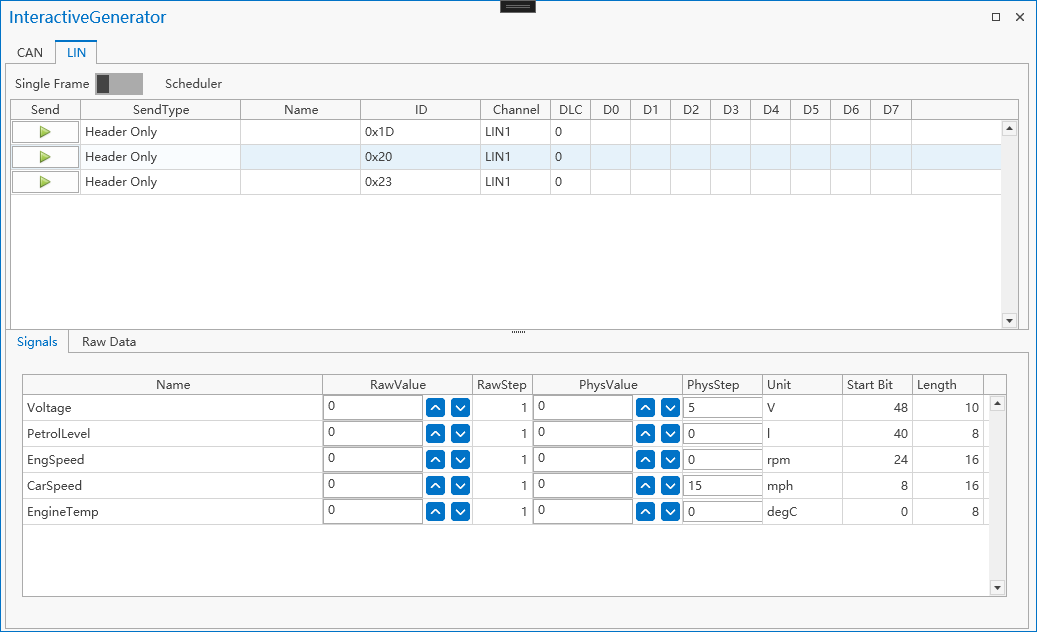Interactive Generator
In this view supports sending CAN/CANFD/LIN frames,but in the current version of the software, Lin only supports the master node and does not support the slave node.
1. CAN Transmit
1.1 Transmit list
The transmit list contains messages to be edited, each message has the following properties:
Send: This is a button controlling the current message transmission. The style of this button depends on the trigger type of the current message:
- Manal transmit message: Each click on this button will trigger one CAN message transmission.
- Periodic transmit message: The first click on this button will start the cyclic transmission of this message. The transmit button will then switch to a Stop button: The next click on this stop button will stop the cyclic transmission of the current message.
Trigger: Message transmission type:
- Manual: One click on the Send button will trigger one CAN message transmission
- Periodic: Click the Send button to transmit periodic CAN message.
Name: The name of the message, if this message is added from CAN database.
Id: Identifier of CAN message.
Channel: The channel number of CAN message.
Type: CAN frame type, can be the one of the following 6 types:
- CAN_Data: Classical CAN data frame with standard identifier
- CAN_Remote: Classical CAN remote frame with standard identifer
- CAN_FD: FD frame with standard identifier
- Extended_CAN_Data: Classical CAN data frame with extended identifier
- Extended_CAN_Remote: Classical CAN remote frame with extended identifier
- Extended_CAN_FD: FD frame with extended identifier
DLC: Data length code of the CAN message, which can be within range 0~15.
interval: The period can be within range from 1ms to 1000ms
D0~D7: Classical CAN data frame data byte editors. Note: In FD CAN frame, these editors are unavailable and replaced by Raw Data editors located on the bottom panel.
1.2 Signals list
Signals list displays editors for modifying signal properties of the selected CAN message defined in CAN database. The raw CAN messages do not have signals list editors.
Signal Name: The signal name defined in the CAN database.
Raw Value: Raw value editor of the current selected signal. To modify a signals raw value without touching its physical value, use this editor.
Raw Step: The increment or decrement step of the Raw Value field.
Physical Value: Physical value editor of the current selected signal. To modify a signals physical value without touching its raw value, use this editor.
Phys Step: The increment or decrement step of the Physical Value field.
2. LIN Transmit
You can use the button to select the single-frame sending mode or the schedule sending mode.
2.1 Transmit list
Send: Each click on this button will trigger one LIN message transmission.
Active: Activate or deactivate the current LIN frame..
Name: The name of the message, if this message is added from LIN database.
Id: Identifier of LIN message.
Channel: The channel number of LIN message.
SendType: LIN frame type, can be the one of the following 6 types:
- Header Only: Send a Header of Lin Frame
- Response Only: Send a Response of Lin Frame
- Header And Response: Send a Header and Response of Lin Frame
DLC: Data length code of the LIN message, which can be within range 0~8.
interval: The period can be within range from 1ms to 1000ms
D0~D7: LIN data frame data byte editors.
2.2 Signals list
Signals list displays editors for modifying signal properties of the selected LIN message defined in LIN database. The raw LIN messages do not have signals list editors.
Signal Name: The signal name defined in the LIN database.
Raw Value: Raw value editor of the current selected signal. To modify a signals raw value without touching its physical value, use this editor.
Raw Step: The increment or decrement step of the Raw Value field.
Physical Value: Physical value editor of the current selected signal. To modify a signals physical value without touching its raw value, use this editor.
Phys Step: The increment or decrement step of the Physical Value field.

